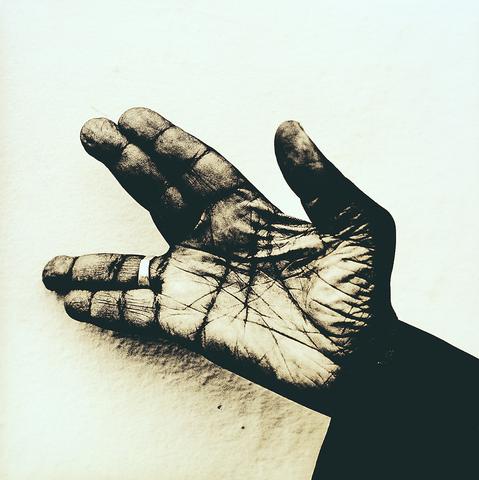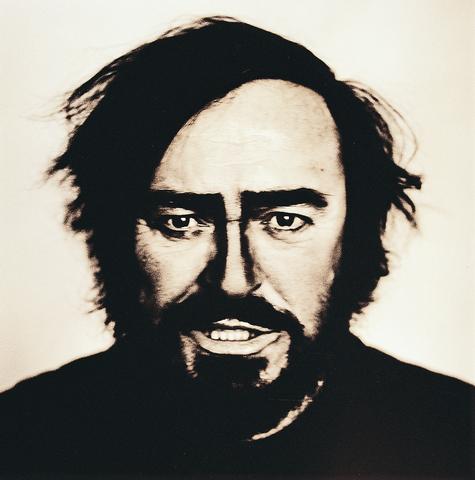In 1985, Anton Corbijn was assigned by the New Musical Express to photograph the legendary jazz player Miles Davis in Montreal. With only a few minutes in Davis' hotel room, the Dutch photographer "asked him to do a few things like that and he did it." The striking result -- a 1.5m tall black-and-white print of Davis pulling at his face -- greets visitors to the Cherng Pin Gallery in the basement of Taipei's flagship Eslite Bookstore.
It is one of Corbijn's best-know images in an exhibition which provides a retrospective of his work over the past 25 years.

PHOTO COURTESY OF TORCH GALLERY, AMSTERDAM
During those years, Corbijn has redefined the concept of rock 'n' roll photography, shooting over 100 album covers and other material for such a wide variety of musicians that most people are likely to have an album featuring one of his covers at home.

PHOTO: COURTESY OF TORCH GALLERY, AMSTERDAM
He has shot the covers of albums by Nick Cave, Metallica, the Rolling Stones, REM, Depeche Mode, John Lee Hooker and, most famously, U2.
In his 18 years of collaboration with the Irish band -- an exceptional feat considering the flakiness of the music world -- Corbijn has managed to twice reinvent their image, so it comes as no surprise that a half-dozen portraits of lead singer Bono are included in the exhibition.
Unfortunately, though, the shots taken for the Joshua Tree album, which have become veritable icons of the group and helped propel them to mega-stardom, are not on show. Unfortunate as well is the series of portraits of Bono, which appears too randomly selected to illustrate the story of the frontman of one of the world's biggest bands.
But there is an ample amount of highlights among the dozens of portraits, which are neatly divided into three "periods."
The largest part of the show is given to what has come to be seen as Corbijn's signature style -- portraits which have a stark, serious and solitary atmosphere, yet in which his subjects also appear at ease.
The intimacy that can be noticed in these medium-format portraits can be explained by the way Corbijn works. Instead of working with elaborate set-ups or numerous assistants -- like celebrity photographer Annie Leibovitz -- Corbijn had just himself, one Hasselblad with two or three lenses and most often nothing more than the available light.
Portraits like those of movie director Steven Spielberg projecting a "movie still" on a wall by folding his hands or of Clint Eastwood in a Dirty Harry pose but pointing his finger instead of a Magnum show that maximum impact can be delivered with minimal means.
In Corbijn's pictures these normally unapproachable celebrities pose as the world has never seen them before: tenor Luciano Pavarotti looks as if in a police mug shot and singer Brian Ferry is leaning on a taxi, wondering if his date will ever turn up.
Corbijn only started shooting these medium-format images after about 15 years of working in 35mm format.
The roots of that early part of his career can be traced back to 1972, when he took a camera to a concert by a local band and sent the results to a paper, which printed them straight away. He later became the chief photographer for the main Dutch pop-music magazine, OOR, for which he captured Elvis Costello in a tiny Amsterdam hotel room in 1977. It is his earliest work on show and also one of the few shots he has taken of musicians actually holding their instruments.
The third part of the retrospective concerns Corbijn's work from 1997 and mainly shows color images taken for his book 33 Still Lives, which he has described as a fictitious documentary of the world of celebrities.
In the style of a paparazzo, he has captured celebrities, with their knowledge and permission, and assigned them various roles he wanted them to play, "like actors in a play by putting them in a situation rather than thinking about their character." Many of these photos resemble stills of imaginary films, like the "untitled film stills" of Cindy Sherman. Among others, there are portraits of Joni Mitchell, shot on a beach in a scene reminiscent of Hitchcock's The Birds," and movie director Lars von Trier, pushing a wheelbarrow in the nude.
Although these color images definitely are a different take on the concept of celebrity photography, they lack the impact of the black-and-white portraits and feel almost like a forced attempt to achieve just that different take.
In addition to photography, Corbijn, who has been living in London since 1979, has directed video clips of artists such as Metallica, U2, the Red Hot Chilli Peppers, Johnny Cash and Depeche Mode (for whom he also has designed stages for their world tours). He also created images for the re-election campaign of Dutch Prime Minister Wim Kok in 1998 and has been dabbling in commercial photography like the portrait of former tennis star Boris Becker for a watch company.
And for those of you who think that the portrait of Miles Davis would look nice in the living room, note that Sotheby's auctioned a print for over US$10,000 late last year.
Art Notes:
What:Anton Corbijn Photopraphy Exhibition
Where: Cherng Pin Gallery, B2 245 Tunghua S. Rd., Sec. 1, Taipei (敦化南路一段245號B2)
When: Until Oct. 21

June 2 to June 8 Taiwan’s woodcutters believe that if they see even one speck of red in their cooked rice, no matter how small, an accident is going to happen. Peng Chin-tian (彭錦田) swears that this has proven to be true at every stop during his decades-long career in the logging industry. Along with mining, timber harvesting was once considered the most dangerous profession in Taiwan. Not only were mishaps common during all stages of processing, it was difficult to transport the injured to get medical treatment. Many died during the arduous journey. Peng recounts some of his accidents in

“Why does Taiwan identity decline?”a group of researchers lead by University of Nevada political scientist Austin Wang (王宏恩) asked in a recent paper. After all, it is not difficult to explain the rise in Taiwanese identity after the early 1990s. But no model predicted its decline during the 2016-2018 period, they say. After testing various alternative explanations, Wang et al argue that the fall-off in Taiwanese identity during that period is related to voter hedging based on the performance of the Democratic Progressive Party (DPP). Since the DPP is perceived as the guardian of Taiwan identity, when it performs well,

The Taiwan People’s Party (TPP) on May 18 held a rally in Taichung to mark the anniversary of President William Lai’s (賴清德) inauguration on May 20. The title of the rally could be loosely translated to “May 18 recall fraudulent goods” (518退貨ㄌㄨㄚˋ!). Unlike in English, where the terms are the same, “recall” (退貨) in this context refers to product recalls due to damaged, defective or fraudulent merchandise, not the political recalls (罷免) currently dominating the headlines. I attended the rally to determine if the impression was correct that the TPP under party Chairman Huang Kuo-Chang (黃國昌) had little of a

A short walk beneath the dense Amazon canopy, the forest abruptly opens up. Fallen logs are rotting, the trees grow sparser and the temperature rises in places sunlight hits the ground. This is what 24 years of severe drought looks like in the world’s largest rainforest. But this patch of degraded forest, about the size of a soccer field, is a scientific experiment. Launched in 2000 by Brazilian and British scientists, Esecaflor — short for “Forest Drought Study Project” in Portuguese — set out to simulate a future in which the changing climate could deplete the Amazon of rainfall. It is